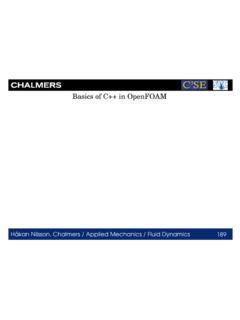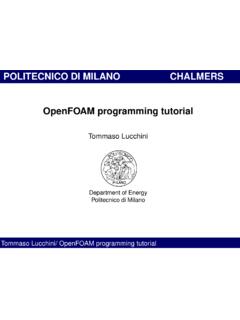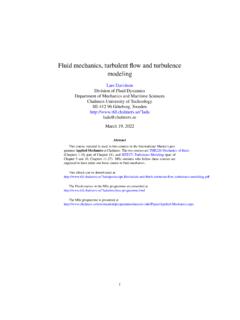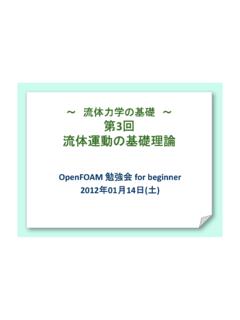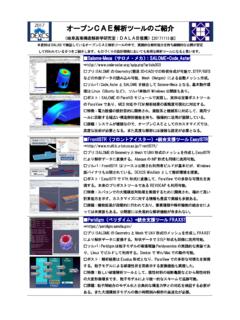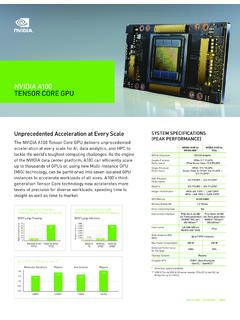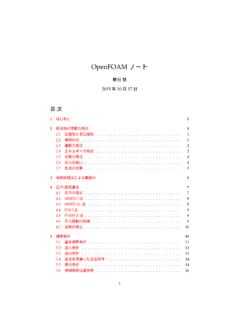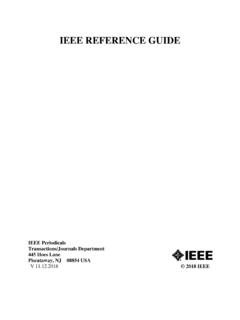Transcription of A Thorough Description Of How Wall Functions Are ...
1 Cite as: Fangqing Liu.: A Thorough Description Of How Wall Functions Are Implemented In Proceedings of CFD with OpenSource Software, 2016, Edited by Nilsson. H., ~hani/kurser/OS_CFD_2016 CFD with OpenSource softwareA course at Chalmers University of TechnologyTaught by H akan NilssonProject work:A Thorough Description Of How WallFunctions Are Implemented InOpenFOAMD eveloped for :FangqingLiuChalmers university of reviewed by:H akan NilssonMohsen IrannezhadLicensed under CC-BY-NC-SA, : This is a student project work, done as part of a course where openfoam and someother OpenSource software are introduced to the students.
2 Any reader should be aware that itmight not be free of errors. Still, it might be useful for someone who would like learn some detailssimilar to the ones presented in the report and in the accompanying files. The material has gonethrough a review process. The role of the reviewer is to go through the tutorial and make sure thatit works, that it is possible to follow, and to some extent correct the writing. The reviewer has noresponsibility for the 22, 2017 Learning outcomesThis tutorial will mainly teach four points: How to use it, The theory of it, How it is implemented,and How to modify it.
3 Therefore the list of learning outcomes is organized with those reader will learn:How to use it: How to set wall Functions as boundary theory of it: The basic principle and derivation of wall it is implemented: The difference of wall Functions between theroy and codes in openfoam . How a solver set boundary condition using wall to modify it: The first step of how to implement a new wall General theoretical Description about wall Introduction .. Why using wall Functions approach .. What are wall Functions .. near wall region.
4 Of wall Functions ..52 Wall Functions in KqRWallFunctions .. V2 WallFunction .. fWallFunctions .. epsilonWallFunctions .. OmegaWallFunctions .. nutWallFunctions .. Conclusion ..273 Structure of wall function and Structure of wall Functions .. Implementing a new wall function ..294 Future work315 Study question322 Chapter 1 General theoretical descriptionabout wall IntroductionIn the present report simple principle of wall Functions will be illustrated and the details of the wallfunctions code in openfoam are explained.
5 The way how wall Functions are used in solver will beillustrated, together with the first step of implementing a new wall Why using wall Functions approachNowadays turbulence models are heavily used when doing CFD simulations. However, some matureturbulence models such as k- are only valid in the area of turbulence fully developed, and don tperform well in the area close to the wall. In order to deal with the near wall region, two waysare usually proposed. One way is to integrate the turbulence to the wall. Turbulence models aremodified to enable the viscosity-affected region to be resolved with all the mesh down to the wall,including the viscous sublayer.
6 When using modified low Reynolds turbulence model to solve thenear-wall region the first cell center must be placed in the viscous sublayer (preferablyy+=1). Thisapproach leads to requirement of abundant mesh number, which means a substantial computationalresource is needed. Another way is to use so-called wall Functions , which can model the near wallregion. Wall Functions are empirical equations used to satisfy the physics of the flow in the near wallregion and the first cell center needs to be placed in the log-law region to ensure the accuracy ofthe result.
7 Wall Functions are used to bridge the inner region between the wall and the turbulencefully developed region, in order to provide near-wall boundary conditions for the momentum andturbulence transport equations, rather than to specify those conditions at the wall itself[1].It can be noted that when using wall Functions approach there is no need to resolve the boundarylayer, which yields to a significant reduction of the mesh size and the computational domain. Despitewall Functions are based on the empirical relations that are only valid under some conditions, theresult is relatively accurate if used correctly ([2]).
8 The wall function approach was first proposed by Launder and Spalding in 1972 ([3]) and the require-ment of the earliest wall Functions is the first cell center at the wall to be located in the logarithmiclayer. If the cell center lies in the viscous sublayer, the results from wall Functions approach are veryinaccurate. However, that is a very strict constraint which will often be violated by the grid. Thussome noble wall Functions are given to reduce this openfoam the existing wall Functions have been modified to ensure that they can provide theaccurate result so wherever the position of the first cell center.
9 The theory of wall Functions used inOpenFOAM is based on the paper proposed by Georgi Kalitzin ([4]). WHAT ARE WALL FUNCTIONSCHAPTER 1. GENERAL THEORETICAL Description ABOUT WALL What are wall functionsThe wall boundary layer, together with some important parameters which are important to defineand derive wall Functions are illustrated. Then the process of wall Functions derivation are should be noted that the main purpose of introducing the derivation of wall Functions is to comparethem with that in openfoam to check how wall Functions are The near wall regionTo know in which condition wall Functions approach can be used correctly, the near-wall regionshould be introduced.
10 Some parameters which be used to introduce the near wall region ([1] [2] ).y+=y u ( )u = w ( )whereu is the friction velocity, which can be used to define dimensionless velocity later. wisthe wall shear stress, y is the distance to the wall andy+is a non-dimensional. The viscosity anddensity of fluid which are used in equation ( ) and ( ) are represented by greek letter nu andrho differently. The value ofy+of the first cell is essential since it judge where the first cell dimensionless velocity is given byu+=uu ( )Then it comes to the near-wall boundary near-wall region can be divided into 3 parties: the viscous sub-layer, the buffer layer and thelogarithmic region.
